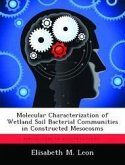Chlorinated ethene's physical properties as well as ubiquitous state at DOD installations makes it a priority for innovative remediation efforts. Current techniques are expensive and time consuming to maintain. Constructed wetlands suggest an inexpensive and operational alternative to conventional technologies. Sub-surface flow wetlands provide the anaerobic zones necessary to reduce the recalcitrant chlorinated solvents prior to anaerobic or aerobic mineralization of its daughter products. A vertical flow cell to include sequential sedimentary layers of two hydric soil lifts and a mix of hydric soil and woody compost was the subject of this investigation. This study focused on the statistical significance among the three constructed strata. Concentrations of mono-carboxylic acids and other anions are indicators of the reductive conditions necessary for remediation. Acid anion concentrations were expected to be higher in the assumed anaerobic strata of the constructed cell as a result of the fermentation of humic substances. Decreases in sulfate and nitrate were also expected over the upward flowing, wetland profile due to the reductive, anoxic conditions. Evidence in this study validate these assumptions and suggest that constructed wetlands are a viable alternative to current remediation methods. Findings also suggest manipulation of the physical parameters such as strata depth, soil type, flow rate, etcof a wetland could increase the cell's remediation effectiveness.








